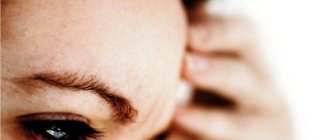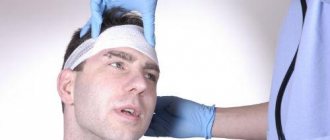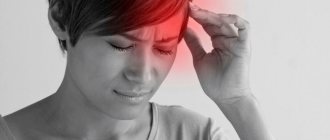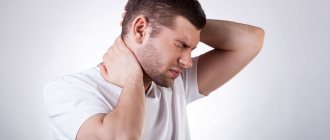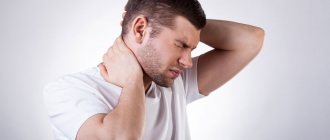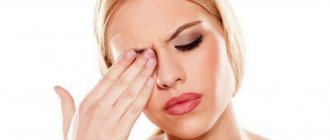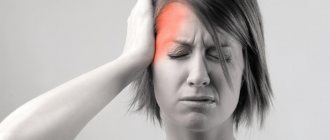Why does the right side of my head hurt?
Physiological reasons
Episodic hemicranias are detected in many healthy people and disappear after taking an anesthetic, sleep, and rest. There is a connection with external circumstances and no tendency to relapse. Provoking factors are considered to be acute and prolonged stress, mental and physical overload. The right side of the head can also hurt due to alcohol intoxication, frequent smoking, or abuse of caffeine-containing drinks.
Migraine
A distinctive feature of migraine is paroxysmal unilateral pain with periodic change of half of the head. For unknown reasons, the disease most often manifests itself as pain in the right side of the head. Painful sensations are localized in the area of the eye, forehead, temple, and less often in the occipital region. They often start in one place and then cover the entire half of the head.
For most types of migraine, symptoms persist for a period of several hours to 3 days. Some signs depend on the type of disease:
- Simple migraine.
The most common. Accompanied by classic attacks without an aura, sometimes preceded by a prodrome in the form of impaired performance, deterioration of the emotional state. Nausea, vomiting, light and sound phobia are noted. - Migraine with aura.
Paroxysms are the same as in the previous case. They are preceded by an aura, which is most often represented by visual disturbances. There may be unusual sounds and smells, sensory disturbances, and difficulty speaking. - Vestibular migraine.
A typical feature is dizziness, which occurs at the prodrome stage and may persist or disappear with the onset of the headache. Sometimes different variants of the aura are observed. - Ocular migraine.
Along with visual disturbances (flickering, the appearance of scotomas, loss of parts of the visual field) that precede cephalalgia and persist for 10-20 minutes, this type of migraine differs from others in its atypical duration - less than 3 hours. - Ophthalmoplegic migraine.
Another variant of the disease with ophthalmological disorders and unusual duration. Symptoms persist for more than a week. Disturbances from the oculomotor, and less commonly, trochlear or abducens nerves occur on days 1-4. Diplopia, mydriasis, strabismus, and drooping eyelids are possible.
If the duration of a migraine attack (except for types with ocular symptoms) is more than 3 days or paroxysms during this time continuously occur one after another, migraine status is diagnosed. This condition is characterized by high pain intensity, wave-like decrease and increase in symptoms, and progressive dehydration caused by repeated vomiting.
Paroxysmal hemicrania
It occurs with episodes of extremely intense pain in the right or left half of the head with the epicenter in the orbit, temporal zone, crown, back of the head, and forehead. It can be provoked by sudden turns of the head, drinking alcohol, or strong emotions. Pain sensations are stabbing, boring, burning, pulsating, aching. The duration of the episode is 5-45 minutes; in severe cases, up to 40 attacks occur during the day. Paroxysmal hemicrania is accompanied by autonomic disorders: lacrimation, local hyperhidrosis, feeling of heat, nasal congestion.
Pain in the right side of the head
Hypnic headache
This primary cephalgia is characterized by its occurrence only during sleep. Separately, the right or left half of the head is affected in 40% of patients; in other cases, the pain is bilateral. At the beginning of the attack, the patient awakens, after the end of the paroxysm he falls asleep again. Hypnic headache is dull, moderate, rarely severe. Diagnosed in people of the older age group, once it appears, it continues to bother throughout life.
Cluster headache
Unlike migraines, the left side of the head is affected more often than the right, but right-sided cephalgia is also possible. The majority of patients are young men. Attacks of cluster headaches develop suddenly, increase within 1-3 minutes, and stop after 15-120 minutes. The painful sensations are extremely intense. Localized mainly in the orbital area, stabbing, burning, tearing, pressing. They decrease with moderate physical activity, so during paroxysm patients constantly move.
Vertebrobasilar insufficiency
Pain in half of the head is typical for the spondylogenic form of the disease. The left and right halves are affected equally often, the localization is determined by the side on which blood flow disturbances occur in the vertebral artery. The pain is provoked by movements of the neck, its severity clearly depends on the position of the head. Painful sensations with vertebrobasilar insufficiency appear in the back of the head, cover the temple, forehead, orbit, and radiate to the upper limb. Accompanied by autonomic and cerebellar disorders, visual and hearing disorders.
Other cerebral pathologies
Pain in the right side of the head is observed with brain tumors, limited arachnoiditis of the corresponding localization. With neoplasms, it appears in the early stages of the disease, strong or moderate, bursting, deep, often observed in the form of attacks. With arachnoiditis, it occurs chronically, gradually progresses, worries mainly in the morning, and is supplemented by neurosis-like symptoms.
Other reasons
Right-sided cephalgia can be detected in the following diseases:
- Sinusitis.
The pain syndrome is bursting, pulsating, provoked by sinusitis or sinusitis of the right paranasal sinuses. It is more pronounced in the forehead area, extending to the temple. Nasal discharge and general signs of an inflammatory process are characteristic. - Mastoiditis.
Manifests simultaneously with acute purulent otitis media or a few days after its onset. There is intense pain behind the ear, spreading to adjacent parts of the head, increased temperature, and drainage of pus from the ear. - Temporal arteritis.
Rheumatic pathology is caused by damage to the temporal artery and is accompanied by throbbing, dull pain in the temple. The pain intensifies at night and gradually progresses. Combined with general intoxication manifestations. - Spinal diseases.
Pain in the right side of the head is caused by right-sided compression of nerves and blood vessels. It is detected in patients with osteochondrosis and intervertebral hernia. Neck pain is typical and gets worse with movement. Possible muscle weakness, numbness of the right hand.
Elderly age
The older a person is, the more often he suffers from throbbing pain in the head, and most often this is associated with pressure and changes in the cervical spine. But there are also a number of reasons that pose a danger to older people, and these include:
- presence of a tumor in the brain;
- presence of hematomas in the brain;
- trigeminal neuralgia;
- temporal arteritis;
- intoxication;
- presence of infectious diseases;
- stroke.
Pain in the head can also be a consequence of menopause in women, weather sensitivity, which occurs in any gender, and depression.
Diagnostics
Determining the pathology that causes pain in the right side of the head is the responsibility of a neurologist. If necessary, the patient is referred for consultation to an otolaryngologist, rheumatologist, or oncologist. To identify focal symptoms, a neurological examination is performed. Diagnosis of primary cephalgia is based on compliance of the clinical picture of the disease with certain criteria. Additional techniques are used during differential diagnosis. For other pathologies, the list of procedures is determined taking into account the nature of the disease. May be assigned:
- Ultrasonography.
Duplex and Doppler sonography are informative in assessing the condition of blood vessels. In case of vertebrobasilar insufficiency, they are performed to study the cervical and intracranial vessels, determine the localization and extent of stenosis. In other cases, they are prescribed to exclude vascular diseases. - Tomography.
Patients with arachnoiditis and tumors are referred for MRI of the brain. If the vertebral artery is damaged, MR angiography is performed. Spinal diseases are diagnosed using CT or MRI of the cervical spine. - Otolaryngological examination.
Necessary for sinusitis, mastoiditis. Along with an external examination, anterior rhinoscopy, otoscopy, and diagnostic puncture of the accessory sinus can be performed. - Radiography.
Images of the cervical spine are recommended for disc herniation, osteochondrosis, and suspected compression of the vertebral artery by surrounding hard structures. X-rays of the temporal bone are indicated for mastoiditis, and of the paranasal sinuses for sinusitis.
Electroencephalography
Symptoms of a stroke in the right hemisphere of the brain
The right hemisphere of the brain is responsible for:
- control of movements of the left side of the body;
- all types of sensitivity of the left half of the body;
- hearing, vision, smell;
- understanding images and symbols;
- feeling of intuition;
- spatial orientation and location perception;
- understanding the figurative meaning of words and metaphors;
- music perception;
- aptitude for fine arts;
- development of fantasy;
- perception of objects as a whole;
- processing a large amount of information simultaneously;
- providing thinking;
- color perception.
A stroke of the right hemisphere of the brain can lead to impairment of one or more of the above functions. In most cases, the motor function of the left limbs is impaired, up to paralysis. The sensitivity of the left side of the face is impaired, but speech is not impaired.
Disturbances are typical for the acute period of stroke; other pathological conditions may appear over time. For example, a person loses the ability to recognize faces and objects, loses the ability to be creative, perceives only the literal meaning of words, not understanding humor.
The earlier a stroke is diagnosed and treatment started, the better the prognosis for the patient.
The Yusupov Hospital has a team of doctors of the highest category, specializing in diseases of the cardiovascular and nervous systems. They accurately diagnose and create an individual treatment program for each patient. The clinic uses modern research methods, including:
- electroneuromyography;
- electromyography;
- video-EEG monitoring;
- duplex scanning;
- neuroimaging and others.
All procedures are performed using modern diagnostic equipment.
Treatment
Conservative therapy
The treatment plan is drawn up taking into account the nature of the disease. The following medications and non-drug methods are used:
- Migraine.
To eliminate paroxysms, non-narcotic analgesics are prescribed. For persistent attacks, blockades are performed. For intense excruciating pain and migraine status, triptans are used in tablets, rectal suppositories, and solutions for parenteral administration. The last two options allow you to solve the problem of taking the drug for persistent vomiting. - Paroxysmal hemicrania.
NSAIDs, glucocorticosteroids, and calcium channel blockers are effective. Depending on the severity of the pathology, medications are taken in short courses or continuously. - Cluster headache.
Painful attacks are eliminated with the help of triptans and applications of local anesthetics to the nasal mucosa. The effectiveness of inhalation of 100% oxygen is noted. Preventive measures in the interictal period are carried out using calcium channel blockers, hormonal, and antiepileptic medications. - Hypnic headache.
The basis of treatment is hypnotics, lithium preparations, and atypical benzodiazepines. Some researchers have reported the effectiveness of steroids and NSAIDs. Before going to bed, patients are advised to take caffeine-containing and melatonin-containing medications. - Vertebrobasilar insufficiency.
Antiplatelet agents, anticoagulants, neuroprotectors, antihypertensive, vascular drugs, exercise therapy, massage, manual therapy, hyperbaric oxygenation, magnetic therapy, laser therapy are recommended. - Tumors.
To reduce the severity of symptoms, non-narcotic and narcotic analgesics, antiemetics, glucocorticoids, and psychotropic drugs are used. Radiation and chemotherapy are carried out as part of palliative therapy or are part of complex treatment in the pre- and postoperative period. - Spinal pathologies.
Pain is eliminated with the help of oral and parenteral forms of NSAIDs, muscle relaxants, and local administration of glucocorticosteroids. They use B vitamins, neurometabolites, phonophoresis, UHF, electrophoresis, and magnetic therapy. - ENT diseases.
Treatment regimens include antibacterial, vasoconstrictor, antihistamines, physiotherapy, paracentesis of the tympanic membrane, and puncture of the paranasal sinuses.
Surgery
Treatment of primary cephalgia is only conservative. For other pathologies, the following may be indicated:
- Vertebrobasilar insufficiency
: reconstructive surgery to restore blood flow. - Brain neoplasia
: removal of cerebral tumors using traditional and minimally invasive surgical techniques. - Spinal diseases
: low-traumatic (endoscopic microdiscectomy, puncture laser vaporization) and traditional (discectomy) interventions for hernias, sometimes in combination with fixation operations. - Pathologies of ENT organs
: sanitizing surgery, mastoidotomy, frontotomy, maxillary sinusotomy, micromaxillary sinusotomy.
Cephalgia and pregnancy
Most often, girls in this position suffer from migraines, and the illness appears from physical activity, food, lack of sleep, stress, and fatigue. There are also other reasons that cause throbbing pain in women in the position:
- VSD;
- blood pressure problems;
- problems with blood supply;
- voltage;
- disorders in the brain;
- sinus inflammation;
- glaucoma.
For pregnant women suffering from cephalalgia, there are recommendations to combat discomfort, namely:
- do a light massage;
- restful sleep;
- take a contrast shower.
Regarding pain relief with medications, in this case it is important to consult a specialist, since not all painkillers are approved for pregnant women.
Combined with nausea
Severe headache and nausea are signs of migraine, meningitis, and hypertensive crisis.
Often the cause of these symptoms is sinusitis, sinusitis, or intoxication of the body. Nausea, headache, and dizziness are also symptoms of traumatic brain injury and infectious diseases. Patients complain of headache, nausea, weakness at the initial stage of influenza and acute respiratory infection. In this case, the body temperature rises to high numbers. The development of a migraine can be signaled by ripples in the eyes, nausea and headache. With a migraine, the patient's appetite disappears, an aversion to strong odors appears, nausea, irritability, photophobia, and numbness in certain parts of the body occur.
Headache and dizziness also occur when wearing incorrectly selected glasses or lenses or disruption of the vascular system. Headaches and spots in the eyes appear due to fatigue and nervous exhaustion, during weather changes, after stress. These symptoms occur in people who have suffered a traumatic brain injury, spinal injury or disease.
Headache and flashing spots before the eyes appear during a hypertensive crisis. Its variety - hyperkinetic crisis - begins abruptly with headache, nausea, flickering of spots before the eyes and vomiting. The patient feels hot. His sweating and heart rate increase. Trembling is felt throughout the whole body. High blood pressure can cause hypertensive encephalopathy. It manifests itself with the following symptoms:
- Very severe headache;
- Dizziness;
- Nausea;
- Vomiting;
- The flickering of flies in the eyes.
The patient may lose consciousness and die if medical care is not provided in a timely manner.
Headaches that occur in the morning after sleep can be a manifestation of a brain tumor, abusive cephalalgia, tension pain, or migraine. Overuse headache occurs with long-term use of analgesics. It gets worse in the morning. The intensity of the pain constantly changes throughout the day. Overuse headaches are aggravated by stress, mental tension, excessive physical activity, and also by stopping a drug that relieves pain. Abuse cephalgia becomes permanent if the patient suffers from depressive syndrome, is often irritated, and is very tired. Due to constant headaches, a person’s concentration and performance decrease. He sleeps poorly and constantly feels tired.
Prevention methods
To prevent headaches, doctors have a number of recommendations that will help maintain the health of nerves and blood vessels. They should be performed from an early age to reduce the risk of strokes and heart attacks, chronic diseases of the veins and arteries. These include:
- giving up bad habits, including smoking and drinking alcohol;
- regular physical activity;
- nutritious nutrition with the addition of important vitamins and microelements to the daily diet;
- wearing hats in the cold season, but they should not squeeze the head;
- systematic monitoring of blood pressure, especially in the presence of hypertension;
- adherence to a daily routine, proper sleep;
- periodic examinations to detect hidden diseases of the heart and blood vessels, neoplasms.
The Clinical Brain Institute specializes in the treatment and diagnosis of headaches of various origins. Our center has modern equipment that makes it possible to conduct examinations of any level of complexity. Doctors are experienced specialists of a wide and narrow profile. They will select an individual treatment regimen, taking into account test results and other features.
Pain with increased intracranial pressure
Intracranial pressure may increase for the following reasons:
- Traumatic brain injury;
- Space-occupying formation in the skull;
- Hydrocephalus – dropsy of the brain;
- Ischemic or hemorrhagic stroke;
- Meningitis, encephalitis.
When intracranial pressure increases, headache occurs in the morning after a person has been in a horizontal position for a long time. It goes away by mid-day. The intensity of the pain increases when the torso is tilted forward, during overexertion, or coughing. It is accompanied by nausea and vomiting, which does not bring relief.
Feelings experienced by the patient
Before consulting a neurologist, the patient should listen to himself so that during the appointment he can describe as accurately as possible exactly how his head hurts at one point. Feelings may be as follows:
- Sharp and sudden pain, reminiscent of a puncture with a sharp needle.
- Localization of the problem: headache in one point - on the top of the head, in the back of the head or in another place.
- The vision becomes dark when an attack occurs, or perhaps the patient lost consciousness during an exacerbation of a migraine.
- During an attack, the patient observes any shadows, flickering on the left or right, darkening of some areas in the field of vision.
It will also be necessary to clarify how long the attacks last - a few seconds or minutes? The more detailed the patient describes the symptoms to the neurologist, the easier it will be to draw up a clinical picture for prescribing appropriate treatment.
How to cure a headache with one injection?
The Center for the Study of Pain of JSC "Medicine" (clinic of Academician Roitberg) uses targeted (targeted) treatment of migraines with the monoclonal antibody drug "Irinex", which is administered subcutaneously by injection. This method has already helped thousands of patients in the USA and Europe, and has now become available in Russia.
Specialists at the Pain Research Center approach migraine treatment in a comprehensive manner. This approach allows us to minimize the impact of the disease on the body and overall health. The combination of various methods of rehabilitation and therapy allows you to achieve excellent results in a short time and a significant improvement in the quality of life.

